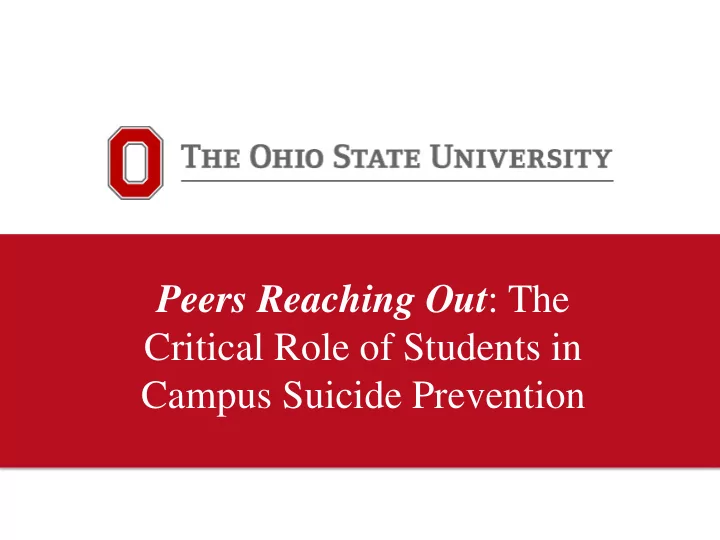

Peers Reaching Out : The Critical Role of Students in Campus Suicide Prevention
• Matthew Fullen, Ph.D., Licensed Professional Clinical Counselor (LPCC) • Program Manager, OSU Suicide Prevention Program suicideprevention.osu.edu @OSUREACH 2
3
Collaboration with University Administration & over 70 campus and community partners • Counseling & Consultation Service • Student Wellness Center • Office of Residence Life • The Graduate School • The Office of Military and Veterans Services 4
Program Structure: • Stand-alone suicide prevention office • 1 full-time program lead • 2 GAAs • 5 undergraduate staff/interns • 1 faculty director • 2 student organizations 5
OSU Suicide Prevention Program Initiatives: • Gatekeeper trainings for students, staff, and faculty (REACH) • Online stress and depression screening (AFSP) • State advocacy (OH Bill 28) • Smartphone app (RUOK: OSU) • Student development initiatives (Today’s focus) 6
7
8
Question: How do we promote mental health and suicide prevention directly to students ? Big Ideas: • Use peer education to provide REACH peer gatekeeper trainings • Support student advocacy efforts to raise campus awareness • Expand direct outreach to at-risk student populations 9
Peer-Led Suicide Prevention & Mental Health Awareness Initiatives • Students may recognize struggling friends prior to parents, staff, and instructors • Peer leaders can de-stigmatize help-seeking behavior among college students (Daddona, 2011) • Peer educators are “students who have been selected, trained, and designated by a campus authority to offer educational services to their peers” (Newton & Ender, 2010, in Catanzarite & Robinson, 2013) 10
Peer-Led Suicide Prevention & Mental Health Awareness Initiatives • Other universities using peers to promote mental health & suicide prevention (Catanzarite & Robinson, 2013; The Campus Suicide Prevention Center of Virginia, 2011): • UNC-Greensboro, “Friends Helping Friends” • SUNY-Albany, “Middle Earth” • Mississippi State University-Meridian, “Student Peer Helper Program” 11
Initiative #1: Use peer educators to lead suicide prevention trainings 12
Peers REACHing Out (“PROs”) Mission Statement: Our purpose is to work with The Ohio State University’s Suicide Prevention Program to: 1. Educate our campus peers on suicide prevention through REACH trainings; 2. Increase awareness and understanding of suicide and its prevention at outreach events; and 3. Advocate for suicide prevention and ending the stigma of mental illness. 13
What is R.E.A.C.H. ? A gatekeeper training program to help the OSU community prevent suicide by teaching faculty, staff, & students how to: R ecognize warning signs E ngage with empathy A sk directly about suicide C ommunicate hope H elp suicidal individuals access care & treatment 14
What is R.E.A.C.H. ? • Developed in 2012 by Dr. Darcy Haag Granello and the OSU Suicide Prevention Program • 2016-17 • We provided over 160+ gatekeeper trainings • Over 4,100 students, staff, & faculty trained as campus gatekeepers • Peer educators used to train student gatekeepers 15
16
Peer Education: Training Steps 1. Students apply to be a part of the “PROs” program 2. Officers lead weekly meetings that focus on learning how to provide the REACH gatekeeper training, safe messaging, public speaking, campus outreach strategies, and key advocacy issues 3. Training provided by OSU Suicide Prevention Program 4. Ongoing mentorship provided by Graduate Associate who is a PhD student in Counselor Education at OSU 17
18
19
20
Initiative #2: Raise awareness & promote mental health advocacy 21
Buckeye Campaign Against Suicide 22
RUOK? Day An event that introduces students to campus & community mental health resources in a fun, stigma-free environment • 2016-17: 1,200 attendees 23
24
Additional Outreach Events 25
26
Initiative #3: Outreach to at-risk populations 27
28
29
30
International and domestic students interact at a cross-cultural cooking and discussion event 31
32
Assessment of Student Initiatives • Across groups/initiatives, 65 students actively involved in suicide prevention efforts on a weekly basis • Benefits to our program: • Constant stream of energy and vitality • Access to parts of campus otherwise blocked • Fresh perspectives on how to promote mental health • Increased exposure for suicide prevention program • Expanded volunteer pool for gatekeeper trainings 33
34
35
36
Next Steps: • Comparison of gatekeeper training outcomes based on presenter type (peer trainer vs. OSU staff trainer) • Data collection scheduled for AY 2017-18 37
How do students benefit from their involvement with the OSU Suicide Prevention Program? (Predragovich, 2015) • Knowledge and education about how to help peers • Strong sense of community • Guidance and mentorship from advisors • Awareness of making a difference in the campus community • Being valued for their efforts • Support from and connection with other like-minded students • Experience being strategic – planning outreach, targeting certain groups 38
For more information: • Contact Dr. Matthew Fullen, Program Manager, at fullen.33@osu.edu • Visit suicideprevention@osu.edu 39
References • Catanzarite, J.A. & Robinson, M.D. (2013). Peer Education in Campus Suicide Prevention. New Directions for Student Services , 141, 43-53. • Daddona, M.F. (2011). Peer Educators Responding to Students with Mental Health Issues. New Directions for Student Services , 133, 29-40. • Newton, F.B. & Ender, S.C. (2010). Students Helping Students. (2 nd ed.) San Francisco: Jossey-Bass. • The Campus Suicide Prevention Center of Virginia. (2011). Peer Involvement in Campus-Based Suicide Prevention: Key Considerations. 40
Recommend
More recommend